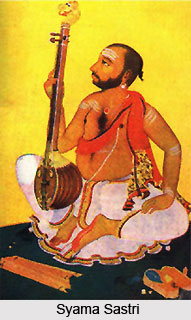 Syama Sastri was a Carnatic music composer of South India. He was born on April 26, 1763 at Venkatakrishna in Tiruvarur, Tamil Nadu. He was the senior most of the trinity of Carnatic music along with Tyagaraja and Muthuswamy Diksitar. He belonged to a scholarly and priestly Tamil Brahmin family of Vishwanatha Iyer. They were not very much interested in music. He was named `Venkatasubramaniam` by his parents.
Syama Sastri was a Carnatic music composer of South India. He was born on April 26, 1763 at Venkatakrishna in Tiruvarur, Tamil Nadu. He was the senior most of the trinity of Carnatic music along with Tyagaraja and Muthuswamy Diksitar. He belonged to a scholarly and priestly Tamil Brahmin family of Vishwanatha Iyer. They were not very much interested in music. He was named `Venkatasubramaniam` by his parents.
At a very young age, Shyama Sastri got the scholarship in Telugu and Sanskrit. He had a very melodious voice but he could not study further than the elementary stages in music education. The family of Syama Sastri moved to Tanjore when he was eighteen years old due to the impending threat of an invasion from Hyder Ali. Maharaja Tulaja provided them shelter in Tanjore. His ancestors used to worship as the hereditary priests of the fabled Bangaru Kamakshi temple of Kanchipuram District. It is said that his ancestors migrated with the idol, from Kanchi to Tiruvarur and finally to Tanjavur over a period of approximately two centuries.
Shyama Sastri used his pen name `Shyama Krishna` in all of his musical compositions. He did not compose many kritis but his works were well known and same as the works of his two creative contemporaries. As he had not much disciples, his works were not spread much. Moreover, the use of printing press was also not possible. It is said that he has almost three hundred music compositions to his credit but only less than hundred odd compositions have been discovered yet. Another reason of less promotion his work is the scholarly nature of his compositions, which did not appeal the common man. It was needed to be studied thoroughly by a knowledgeable person also to get the meaning.
Most of the compositions of Shyama Sastri were on goddess Devi and were written in Telugu, Sanskrit and Tamil. It is said that the swarajati musical form was sculptured by him. The three famous swarajatis by him are known as `Ratna Trayam`. These are in Bhairavi, Yadukulakamboji and Todi. Sangita Swami, a great musical promoter and a sanyasi from Benares came under him to take teachings on his compositions as well as to take care of his musical education. Shyama Sastri directed this young Yogi to hone his musical skills by listening to Pacchimiriyam Adiappiah, the composer of the famous Viriboni varnam after his tenure was over here.
`Janani-natajana-paripaliniinthe rajja Saveri` is supposed to be Shyama Sastri`s first musical composition. In this composition he did not attach his mudra (signature) but the three usual chiranas can be found in it. The musical legacy of Shyama Sastri also includes four varnams, and nwajatis, which he presented with hitherto undiscovered dimensions. Some of his varnams are in unusual like Tisra Matya and Chatusra Ata. The Ananda Bhairavi varnam of Shyama Sastri has an additional sahitya (lyrics) in the charanam called the `anubandham`. But, he is still placed in the higher position in Carnatic music due to his original interpretation of the `Svarajati`.
The three svarajatis by Shyama Sastri in Bhairavi, Todi and Yadukula Kambodhi, supplied with musical shade and displaying intellectual virtuosity placed him as the unparalleled king of this art form. His kritis had a unique quality, which could move even a dull and uninteresting listener. Numerous ragas can be seen in his compositions like the Chintamani, Kalgada, Manji and Paraju raga. The raga `Chintamani` was first used in his composition. He also composed in a unique style by giving two compositions for a similar musical setting (dhatu). He used Himadrisute and Birana varalichi (Kalyani) both sung to the same musical setting. Shyama Sastri was very fond of the literary beauties like `svarakshara` and used them in his compositions. His works also show a marked desire of him for the details of `laya` and `tala` in his compositions. These virtues of his compositions earned him the epithet `Tala Prastara Syama Sastri`.
The compositions of Shyama Sastri show that the intricacies of tala can peacefully co-exist with melodic beauty. He was inclined towards the Chapu tala and was the first composer who used the `viloma chapu` tala in the reverse style. An interesting fact about his songs was that many of his songs could be sung comfortably in two different talas. Therefore, these kritis of him were known as the `dvi-tala kritis`. Shyama Sastri was the first one to sing a composition in the Sarabhanandana tala. He sang it in a contest with a visiting musician named Bobbili Kesavayya in the Tanjavur court. No mention of this 79 Akshara tala is found in any earlier references.




















